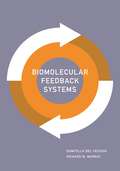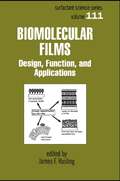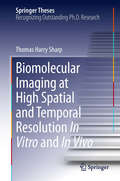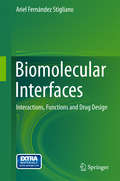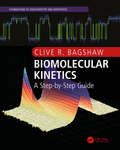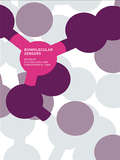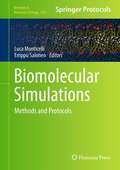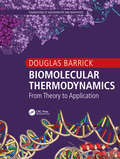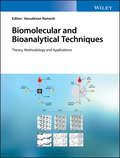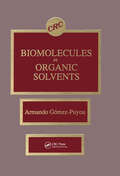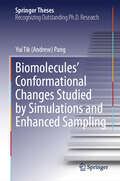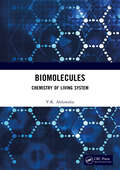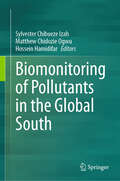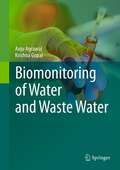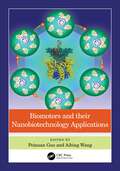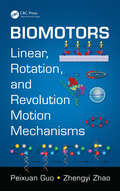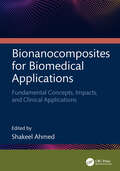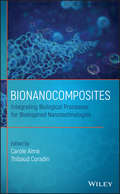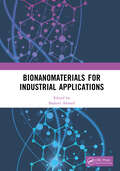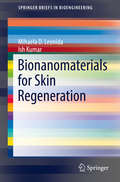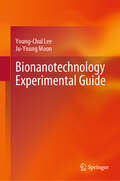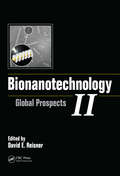- Table View
- List View
Biomolecular Feedback Systems
by Richard Murray Domitilla Del VecchioThis book provides an accessible introduction to the principles and tools for modeling, analyzing, and synthesizing biomolecular systems. It begins with modeling tools such as reaction-rate equations, reduced-order models, stochastic models, and specific models of important core processes. It then describes in detail the control and dynamical systems tools used to analyze these models. These include tools for analyzing stability of equilibria, limit cycles, robustness, and parameter uncertainty. Modeling and analysis techniques are then applied to design examples from both natural systems and synthetic biomolecular circuits. In addition, this comprehensive book addresses the problem of modular composition of synthetic circuits, the tools for analyzing the extent of modularity, and the design techniques for ensuring modular behavior. It also looks at design trade-offs, focusing on perturbations due to noise and competition for shared cellular resources.Featuring numerous exercises and illustrations throughout, Biomolecular Feedback Systems is the ideal textbook for advanced undergraduates and graduate students. For researchers, it can also serve as a self-contained reference on the feedback control techniques that can be applied to biomolecular systems.Provides a user-friendly introduction to essential concepts, tools, and applicationsCovers the most commonly used modeling methodsAddresses the modular design problem for biomolecular systemsUses design examples from both natural systems and synthetic circuitsSolutions manual (available only to professors at press.princeton.edu)An online illustration package is available to professors at press.princeton.edu
Biomolecular Films: Design, Function, and Applications (Surfactant Science Ser. #111)
by James F. RuslingThis text examines films of biomolecules that can provide solid surfaces for catalyzing enzyme reactions, serve in biosensors and as biorecognition elements, mediate nanoparticle formation, and provide a basis for fundamental studies and applications in biomedicine and biomedical devices.
Biomolecular Imaging at High Spatial and Temporal Resolution In Vitro and In Vivo (Springer Theses)
by Thomas Harry SharpAs part of a collaboration between two different groups in chemistry and biochemistry, Thom Sharp presents here his thesis work on the development of new methods for cryoelectron microscopy. Throughout his Ph. D. , Thom had to master a whole range of techniques including modelling, molecular biology and microscopy. Using these skills to tackle an outstanding problem, the pursuit of high-resolution structures of peptide-based materials, Thom highlights in this thesis his newly developed methods for analysing and processing this particular type of electron microscopy data. This thesis gives the first molecular description of a de-novo designed peptide-based material. In general, this research will have a huge impact on the peptide assembly field, and also in electron microscopy as it introduces new methods and approaches, all of which are Thom's inventions and are described in this thesis.
Biomolecular Information Processing
by Evgeny KatzEdited by a renowned and much cited chemist, this book covers the whole span of molecular computers that are based on biomolecules. The contributions by all the major scientists in the field provide an excellent overview of the latest developments in this rapidly expanding area. A must-have for all researchers working on this very hot topic. Perfectly complements Molecular and Supramolecular Information Processing, also by Prof. Katz, and available as a two-volume set.
Biomolecular Interfaces: Interactions, Functions and Drug Design
by Ariel Fernández StiglianoThe book focuses on the aqueous interface of biomolecules, a vital yet overlooked area of biophysical research. Most biological phenomena cannot be fully understood at the molecular level without considering interfacial behavior. The author presents conceptual advances in molecular biophysics that herald the advent of a new discipline, epistructural biology, centered on the interactions of water and bio molecular structures across the interface. The author introduces powerful theoretical and computational resources in order to address fundamental topics such as protein folding, the physico-chemical basis of enzyme catalysis and protein associations. On the basis of this information, a multi-disciplinary approach is used to engineer therapeutic drugs and to allow substantive advances in targeted molecular medicine. This book will be of interest to scientists, students and practitioners in the fields of chemistry, biophysics and biomedical engineering.
Biomolecular Kinetics: A Step-by-Step Guide (Foundations of Biochemistry and Biophysics)
by Clive R. Bagshaw"a gem of a textbook which manages to produce a genuinely fresh, concise yet comprehensive guide"–Mark Leake, University of York "destined to become a standard reference…. Not just a ‘how to’ handbook but also an accessible primer in the essentials of kinetic theory and practice."–Michael Geeves, University of Kent "covers the entire spectrum of approaches, from the traditional steady state methods to a thorough account of transient kinetics and rapid reaction techniques, and then on to the new single molecule techniques" –Stephen Halford, University of Bristol This illustrated treatment explains the methods used for measuring how much a reaction gets speeded up, as well as the framework for solving problems such as ligand binding and macromolecular folding, using the step-by-step approach of numerical integration. It is a thoroughly modern text, reflecting the recent ability to observe reactions at the single-molecule level, as well as advances in microfluidics which have given rise to femtoscale studies. Kinetics is more important now than ever, and this book is a vibrant and approachable entry for anyone who wants to understand mechanism using transient or single molecule kinetics without getting bogged down in advanced mathematics. Clive R. Bagshaw is Emeritus Professor at the University of Leicester, U.K., and Research Associate at the University of California at Santa Cruz, U.S.A.
Biomolecular Sensors
by Christopher R. Lowe Electra GizeliThe development of devices that incorporate biological assemblies is impacting analytical and biomedical research. Today, scientists can monitor vital biological interactions-such as the binding of DNA to proteins-in real time, deriving unique information necessary to understanding biochemical pathways and thus aiding the design of drugs to regulat
Biomolecular Simulations: Methods and Protocols (Methods in Molecular Biology #2022)
by Massimiliano Bonomi Carlo CamilloniThis volume explores the recent advancements in biomolecular simulations of proteins, small molecules, and nucleic acids, with a primary focus on classical molecular dynamics (MD) simulations at atomistic, coarse-grained, and quantum/ab-initio levels. The chapters in this book are divided into four parts: Part One looks at recent techniques used in the development of physic-chemical models of proteins, small molecules, nucleic acids, and lipids; Part Two discusses enhanced sampling and free-energy calculations; Part Three talks about integrative computational and experimental approaches for biomolecular simulations; and Part Four focuses on analyzing, visualizing, and comparing biomolecular simulations. Written in the highly successful Methods in Molecular Biology series format, chapters include introductions to their respective topics, lists of the necessary materials and reagents, step-by-step, readily reproducible laboratory protocols, and tips on troubleshooting and avoiding known pitfalls. Cutting-edge and comprehensive, Biomolecular Simulations: Methods and Protocols is a valuable resource for both novice and expert researchers who are interested in studying different areas of biomolecular simulations, and discovering new tools to progress their future projects.
Biomolecular Simulations: Methods and Protocols (Methods in Molecular Biology #924)
by Emppu Salonen Luca MonticelliOver the past 40 years the field of molecular simulations has evolved from picosecond studies of isolated macromolecules in vacuum to studies of complex, chemically heterogeneous biological systems consisting of millions of atoms, with the simulation time scales spanning up to milliseconds. In Biomolecular Simulations: Methods and Protocols, expert researchers illustrate many of the methods commonly used in molecular modelling of biological systems, including methods for electronic structure calculations, classical molecular dynamics simulations and coarse-grained techniques. A selection of advanced techniques and recent methodological developments, which rarely find coverage in traditional textbooks, is also introduced. Written in the highly successful Methods in Molecular Biology series format, chapters include general introductions to well-established computational methodologies, applications to real-world biological systems, as well as practical tips and general protocols on carrying out biomolecular simulations. Special emphasis is placed on simulations of proteins, lipids, nucleic acids, and carbohydrates. Authoritative and practical, Biomolecular Simulations: Methods and Protocols seeks to aid scientists in further simulation studies of biological systems.
Biomolecular Thermodynamics: From Theory to Application (Foundations of Biochemistry and Biophysics)
by Douglas Barrick"an impressive text that addresses a glaring gap in the teaching of physical chemistry, being specifically focused on biologically-relevant systems along with a practical focus…. the ample problems and tutorials throughout are much appreciated." –Tobin R. Sosnick, Professor and Chair of Biochemistry and Molecular Biology, University of Chicago "Presents both the concepts and equations associated with statistical thermodynamics in a unique way that is at visual, intuitive, and rigorous. This approach will greatly benefit students at all levels." –Vijay S. Pande, Henry Dreyfus Professor of Chemistry, Stanford University "a masterful tour de force…. Barrick's rigor and scholarship come through in every chapter."–Rohit V. Pappu, Edwin H. Murty Professor of Engineering, Washington University in St. Louis This book provides a comprehensive, contemporary introduction to developing a quantitative understanding of how biological macromolecules behave using classical and statistical thermodynamics. The author focuses on practical skills needed to apply the underlying equations in real life examples. The text develops mechanistic models, showing how they connect to thermodynamic observables, presenting simulations of thermodynamic behavior, and analyzing experimental data. The reader is presented with plenty of exercises and problems to facilitate hands-on learning through mathematical simulation. Douglas E. Barrick is a professor in the Department of Biophysics at Johns Hopkins University. He earned his Ph.D. in biochemistry from Stanford University, and a Ph.D. in biophysics and structural biology from the University of Oregon.
Biomolecular and Bioanalytical Techniques: Theory, Methodology and Applications
by Vasudevan RameshAn essential guide to biomolecular and bioanalytical techniques and their applications Biomolecular and Bioanalytical Techniques offers an introduction to, and a basic understanding of, a wide range of biophysical techniques. The text takes an interdisciplinary approach with contributions from a panel of distinguished experts. With a focus on research, the text comprehensively covers a broad selection of topics drawn from contemporary research in the fields of chemistry and biology. Each of the internationally reputed authors has contributed a single chapter on a specific technique. The chapters cover the specific technique’s background, theory, principles, technique, methodology, protocol and applications. The text explores the use of a variety of analytical tools to characterise biological samples. The contributors explain how to identify and quantify biochemically important molecules, including small molecules as well as biological macromolecules such as enzymes, antibodies, proteins, peptides and nucleic acids. This book is filled with essential knowledge and explores the skills needed to carry out the research and development roles in academic and industrial laboratories. A technique-focused book that bridges the gap between an introductory text and a book on advanced research methods Provides the necessary background and skills needed to advance the research methods Features a structured approach within each chapter Demonstrates an interdisciplinary approach that serves to develop independent thinking Written for students in chemistry, biological, medical, pharmaceutical, forensic and biophysical sciences, Biomolecular and Bioanalytical Techniques is an in-depth review of the most current biomolecular and bioanalytical techniques in the field.
Biomolecules in Organic Solvents
by Armando Gomez-PuyouBiomolecules and Organic Solvents discusses the behavior of enzymes and multi-enzyme complexes in organic solvents, in addition to the problem of water-protein interactions and the characteristics of water at interphases. It attempts to bridge the gap between the all water and the organic solvents systems from the point of view of enzyme structure and function. The mechanism of action of enzymes dispersed in anhydrous organic solvents and the biotechnological perspectives of the field are evaluated, and new information regarding the function and characteristics of complex multi-enzymatic systems and whole cells in organic solvents are examined. New developments regarding the nature of the water pool and interphases of reverse micelles and their enzyme kinetics are also explored. The characteristics and properties of enzymes trapped in reverse micelles are discussed throughout the book. Biomolecules in Organic Solvents is essential reading for biochemists, molecular biologists, and others working in related fields.
Biomolecules' Conformational Changes Studied by Simulations and Enhanced Sampling (Springer Theses)
by Yui Tik PangThis thesis illuminates the critical roles biomolecules, from small molecules to proteins, play in cellular functionality, particularly highlighting their conformational changes in response to environmental cues or binding events—a cornerstone concept in drug design as well as the manifestations of disease. It explores the conformational flexibility of small molecules and proteins, essential for predicting drug interactions and understanding biological processes. Through advanced molecular dynamics simulations and enhanced sampling techniques, this research offers unprecedented insights into the structural dynamics of three distinct biomolecular systems: the capsid assembly modulator AT130, the passenger domain of pertactin, and the SARS-CoV-2 spike protein. Each system represents a unique facet of biological complexity, underscoring the thesis's contribution to our understanding of biomolecular behavior across various scales. Furthermore, the thesis advances the field by updating the Force Field Toolkit for improved simulation accuracy. This work not only showcases the adaptability and importance of simulation techniques in modern biological research but also paves the way for novel therapeutic strategies by deepening our understanding of biomolecular dynamics.
Biomolecules: Chemistry of Living System
by V.K. AhluwaliaBiomolecules, also known as molecules of life, are essential for sustaining life processes. This book presents a study of these crucial biological substances to explore their function, structure, biological role, and synthesis. It also expands upon the various types of biomolecules and discusses their individual characteristics.The subject matter of this book also covers: Mucopolysaccharides Tertiary Structure of Proteins Caffeine Mechanism of Enzyme Action Biosythesis of Haemoglobin Print edition not for sale in South Asia (India, Sri Lanka, Nepal, Bangladesh, Pakistan or Bhutan)
Biomonitoring of Pollutants in the Global South
by Sylvester Chibueze Izah Matthew Chidozie Ogwu Hossein HamidifarThe edited book serves as a reference on indicators of environmental pollution and how to sustainably ascertain the effects of different pollutants on life forms. It addresses an improved technology for monitoring contaminants, especially in the Global South and beyond, where the level of technology available for sustainable management of environmental quality is limited. Biomonitoring ecosystems' health by using organisms to gather quantitative data on environmental quality is one of the most straightforward and affordable ways to check environmental quality. Since organisms may function as environmental sensors, their use in the direct measurement of environmental quality in the process of biomonitoring studies implicates the health status of various ecosystems. In this regard, microorganisms, higher and lower plants, invertebrates, and vertebrate animals are beneficial since they can detect pollution levels and pollutants in the environment. This book is of interest and useful to toxicologists, water, soil, and air quality experts, practitioners, trainees, and trainers, biological sciences scientists, academicians, researchers, students (especially undergraduates and postgraduates), libraries, and other public knowledge repositories interested in novel and advanced practices in sustainable biomonitoring of environmental pollutants.
Biomonitoring of Water and Waste Water
by Krishna Gopal Anju AgrawalBiomonitoring of water quality is very much essential for assessing the overall health of water bodies and safe supply of drinking water. The chemical nature of toxicant is highly dynamic in environment with time and space whereas biological system can integrate all environmental variables over a large period of time in terms of effect that can be easily measured and quantified. In view of the above, there is a pressing need to determine the water quality of natural resources as well as drinking water based on the standard protocols and guidelines from regulatory agencies. It is clear that the synthetic chemicals are essential for our society to maintain the health and well being of the people. However, there has been a range of detrimental effects on human health and natural environment. In general, we need to improve our management of waste chemicals discharged into the air, water and soil environments. New techniques are needed to predict adverse effects before they occur and for the treatment of wastes. In addition, a range of social, political and economic factors will be needed to be taken into account in order to achieve success.
Biomotors and their Nanobiotechnology Applications
by Peixuan GuoThis book – a collection of reviews and research articles by the top academics in the field – provides a glimpse of the cutting-edge technology and research being carried out and shows how researchers are utilizing this knowledge to develop new areas of study and novel applications. It serves as a valuable resource while exploring the latest advances in virus particle assembly and demonstrating how the knowledge of fundamental processes has been used to advance bio-nanotechnology. Chapters detail biophysical approaches and biomotor research, discus the latest advances in DNA/RNA nanoparticle assembly and use, and introduce the use of DNA/RNA nanoparticles for drug delivery.
Biomotors: Linear, Rotation, and Revolution Motion Mechanisms
by Peixuan Guo and Zhengyi ZhaoThis book provides a comprehensive overview of biomotors (molecular motors) within the body with a specific concentration on revolving molecular motors. The bioengineering of these new revolving molecular motors will go a long way in creating machines that will be able to carry RNA and DNA drugs directly to diseased cells to destroy them. The book goes into specific details regarding the bioengineering, fabrication, synthesis, and future utilization of these devices for nanomedicine.
Bionanocomposites for Biomedical Applications: Fundamental Concepts, Impacts, and Clinical Applications
by Shakeel AhmedThis book examines bionanocomposites in the biomedical field from a fundamental level to in-depth applications using an interdisciplinary approach that combines polymer technology, nanotechnology, biomedical science, and pharmaceutical research. Advancements of bionanocomposites in biomedical applications, such as wound dressings, tissue engineering, drug delivery, bioimaging, biosensing, 3D-printing, medical implants, and many more, are comprehensively summarized and supported by a number of case studies. Features: Discusses properties, classifications, and synthesis of bionanocomposites in addition to applications. Each chapter focuses on the application of bionanocomposites. Reviews cytotoxicity and biocompatibility of bionanocomposites. Explores safety aspects of bionanocomposites. Covers wound healing, nerve regeneration, biosensors, skin regeneration, drug delivery, and so forth. This book is aimed at graduate students and researchers in chemical, polymer, tissue, and biomedical engineering.
Bionanocomposites: Integrating Biological Processes for Bioinspired Nanotechnologies
by Thibaud Coradin Carole AiméBeginning with a general overview of nanocomposites, Bionanocomposites: Integrating Biological Processes for Bio-inspired Nanotechnologies details the systems available in nature (nucleic acids, proteins, carbohydrates, lipids) that can be integrated within suitable inorganic matrices for specific applications. Describing the relationship between architecture, hierarchy and function, this book aims at pointing out how bio-systems can be key components of nanocomposites. The text then reviews the design principles, structures, functions and applications of bionanocomposites. It also includes a section presenting related technical methods to help readers identify and understand the most widely used analytical tools such as mass spectrometry, calorimetry, and impedance spectroscopy, among others.
Bionanomaterials for Biosensors, Drug Delivery, and Medical Applications (Emerging Materials and Technologies)
by Suresh Sagadevan Won-Chun OhThis book covers advances in nanostructured materials across a variety of biomedical applications as the field evolves from development of prototype devices to real-world implementation. It provides an in-depth look at the current state of the art in oxide nanostructures, carbon nanostructures, and 2D material fabrication and highlights the most important biomedical applications and devices of nanomaterials, including drug delivery, medical imaging, gene therapy, biosensors, and diagnostics. FEATURES Presents the findings of cutting-edge research activities in the field of nanomaterials, with a particular emphasis on biological and pharmaceutical applications Details finished and ongoing toxicity evaluations of emerging nanomaterials Offers a multidisciplinary perspective This book is recommended for senior undergraduate and graduate students, professionals, and researchers working in the fields of bioengineering, materials science and engineering, and biotechnology.
Bionanomaterials for Industrial Applications
by Shakeel AhmedBionanomaterials for Industrial Applications is a comprehensive guide to the current state of bionanomaterials research and their prospective applications in a variety of industrial sectors. The book discusses the properties of bionanomaterials, types and their potential applications in various disciplines, such as biomedicine, food industry, environment, etc. It provides a comprehensive overview of the current state of bionanomaterials research and their potential applications, making it an indispensable resource for anyone interested in learning more about this dynamic and rapidly developing field.Features: Discusses properties, classifications, and synthesis of bionanomaterials in addition to industrial applications Covers circular economy and life cycle assessment of bionanomaterials Explores impact of bionanomaterials on environment and human health Includes individual chapters specifically focusing on a particular application of bionanomaterials Reviews detailed industrial applications in particular field viz. environmental, food sciences, biomedical, and so forth This book is designed for researchers, scientists, engineers, and graduate students working in the field of bionanomaterials, as well as industrial professionals who could benefit from the use of bionanomaterials.
Bionanomaterials for Skin Regeneration (SpringerBriefs in Bioengineering)
by Mihaela D. D. Leonida Ish KumarThis book gives a concise overview of bionanomaterials with applications for skin regeneration. The advantages and challenges of nanoscale materials are covered in detail, giving a basic view of the skin structure and conditions that require transdermal or topical applications. Medical applications, such as wound healing, care for burns, skin disease, and cosmetic care, such as aging of the skin and photodamage, and how they benefit from bionanomaterials, are described in detail. A final chapter is devoted to the ethical and social issues related to the use of bionanomaterials for skin regeneration. This is an ideal book for researchers in materials science, medical scientists specialized in dermatology, and cosmetic chemists working in formulations. It can also serve as a reference for nanotechnologists, dermatologists, microbiologists, engineers, and polymer chemists, as well as students studying in these fields.
Bionanotechnology Experimental Guide
by Young-Chul Lee Ju-Young MoonThis book examines the fascinating field of bionanotechnology, which combines biology with the design, development, and uses of materials at the nanoscale. A thorough introduction to nanotechnology and nanomaterials, emphasizing their creation, characterization, and biological uses, is provided in the beginning of the book. The basics and applications of nanotechnology in numerous scientific fields will be clearly understood by readers. The integration of nanomaterials and nanotechnology in several fields, including medicine development, genomics, microbiology, proteomics, animal cell culture, in -vitro biology testing, and even cosmetics, is covered in more detail in later chapters. Examine how these sectors are changing as a result of nanotechnology, which is opening up new possibilities for innovation and development. Additionally, this book strives to create a balance between complex ideas and understandable language. The plain writing approach ensures accessibility without sacrificing the book's intellectual tone. The explanation of complex ideas is useful and entertaining. An additional chapter in this book describes the procedures for creating an academic report. This book provides you the knowledge and abilities you need to effectively explain scientific discoveries, whether you're a researcher, scientist, or student.
Bionanotechnology II: Global Prospects
by David E. ReisnerThe impact and importance of nanotechnology continues to grow, and nanomedicine and biotechnology have become areas of increased development. Biomedical engineers who work with biological processes and structures must have a deeply rooted understanding of the role of bionanotechnology, a rapidly evolving sector of the nanotechnology field. Bionanot
